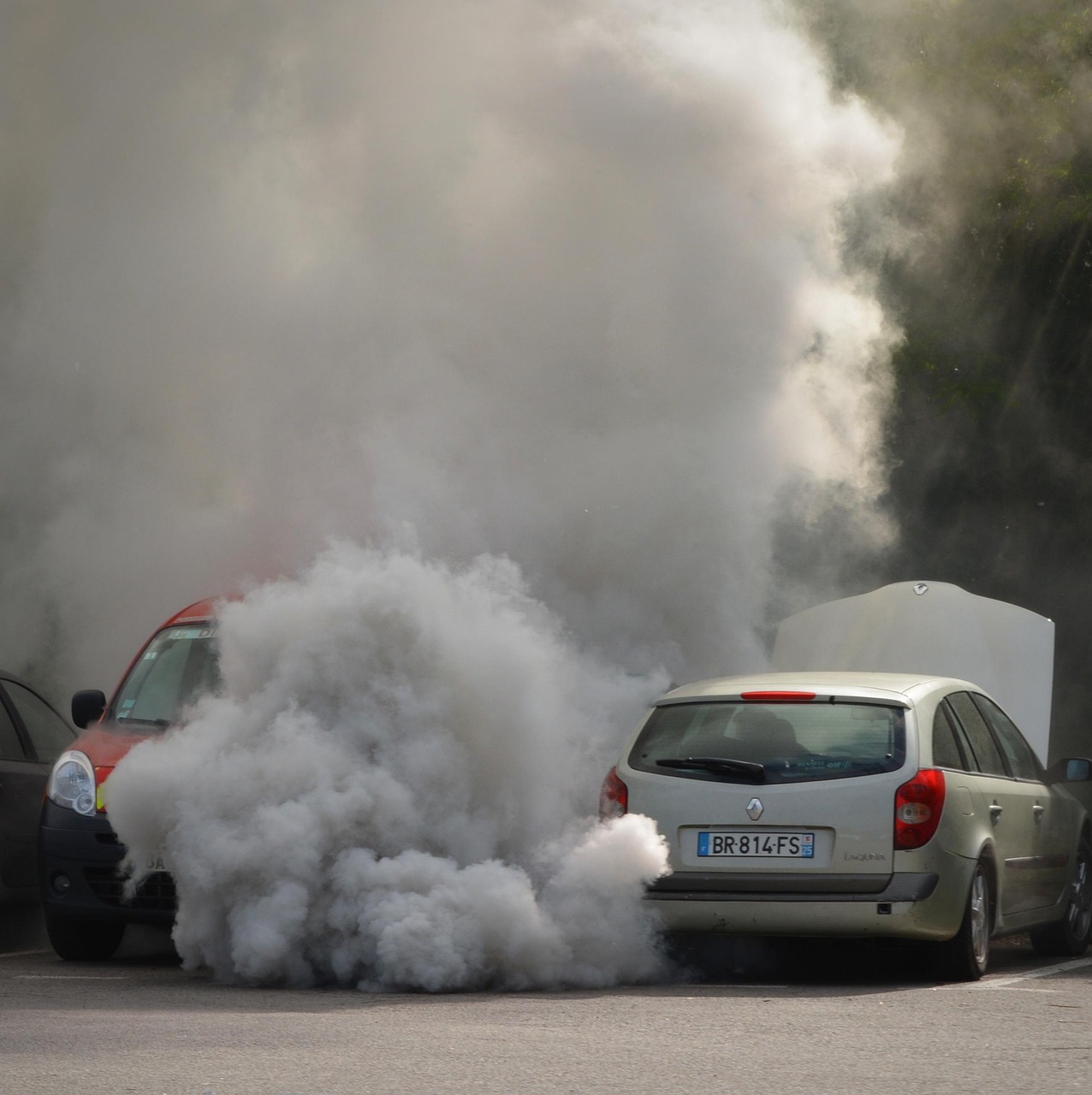If you see white smoke coming from your car’s exhaust when you start it up, don’t panic just yet because sometimes it’s completely normal and other times it could mean trouble under the hood. Knowing how to tell the difference can save you a lot of time, money, and stress.
As someone who has owned more cars than I can count and dealt with this exact issue more than once, I’ve learned that white smoke is one of those things that can either be harmless or a big red flag. The key is knowing what type of smoke you’re seeing, how long it lasts, and whether your car is showing any other symptoms.
Let’s go through the main causes of white exhaust smoke, what they mean, and how you can figure out whether it’s time to visit a mechanic.
1. Normal Water Vapor on Cold Mornings
The most common reason you see white smoke from your exhaust when you start the car is simple water vapor. This is especially true on chilly mornings. When the engine is cold, condensation forms inside the exhaust system overnight. As you start your car, that moisture turns into steam, which looks like thin white smoke.
This kind of smoke usually disappears within a few minutes once the engine warms up. It’s light, almost misty, and doesn’t smell unusual. If you can still see the smoke after the car has been running for a while, though, that’s when you should start paying closer attention.
What to do:
If it’s just thin vapor that goes away, you don’t have to worry. This is completely normal and happens to almost every car, especially during cold or humid mornings.
2. Coolant Leaking Into the Engine (Blown Head Gasket or Cracked Cylinder Head)
If the white smoke is thick and doesn’t go away after a few minutes, it might mean your coolant is leaking into the engine and getting burned along with the fuel. This usually points to a blown head gasket, a cracked cylinder head, or even a damaged engine block.
When coolant burns, it creates dense, sweet-smelling white smoke that lingers longer than normal condensation. You might also notice your coolant level dropping faster than usual or see milky, frothy oil under the cap, which means coolant is mixing with oil.
Symptoms of a coolant leak include:
- Constant white smoke from the exhaust, even after warming up
- Sweet smell in the exhaust
- Engine overheating
- Bubbles in the radiator or coolant reservoir
- Low coolant level with no visible leak under the car
This is a serious issue because a blown head gasket can lead to complete engine failure if ignored.
What to do:
Stop driving and have a mechanic inspect it immediately. Continuing to drive can warp your engine components and lead to expensive repairs.
3. Residual Condensation in the Exhaust System
Even when it’s not cold outside, water can still collect in your exhaust system if your car sits for long periods. This trapped condensation can cause a small puff of white smoke when you start the engine after a few days or weeks of inactivity.
It’s not a big deal if it disappears quickly. You might even notice some water dripping out of the tailpipe, which is totally normal.
What to do:
If you don’t drive your car often, consider taking it for a longer drive every week or so. This helps the exhaust system get hot enough to evaporate moisture, preventing rust and buildup inside.
4. Transmission Fluid Burning (in Automatic Cars)
In rare cases, white smoke can come from transmission fluid being sucked into the engine through a faulty vacuum modulator. This mostly happens in older cars with automatic transmissions.
If this is the cause, you’ll likely notice the smoke has a bluish tint rather than pure white, and it will smell sharp and oily. You might also notice the transmission shifting roughly or slipping.
What to do:
Check your transmission fluid level. If it’s dropping and you see white or bluish smoke, you’ll need to get the vacuum modulator or related components replaced.
5. Faulty Fuel Injector or Bad Fuel Mixture
If your engine is getting too much fuel or not enough air, it can create incomplete combustion. Although this usually results in black or gray smoke, a very light mist of white smoke can sometimes appear when fuel isn’t burning efficiently, especially on startup.
Modern engines use sensors to regulate the air and fuel mixture, but if one of those sensors fails or if a fuel injector leaks, you might see white smoke and rough idling.
What to do:
If the smoke is accompanied by poor performance, misfiring, or the smell of unburned fuel, have your mechanic check the injectors and oxygen sensors.
6. Burning Oil (Grayish White Smoke)
Sometimes what looks like white smoke is actually light gray smoke from burning oil. This can happen if oil leaks past worn piston rings or valve seals and enters the combustion chamber.
You’ll notice this more when revving the engine or accelerating after idling. The smoke may smell oily and linger longer than normal condensation.
What to do:
Check your oil level. If it’s dropping steadily and you don’t see leaks under the car, oil is likely being burned internally. Worn piston rings or valve seals may need replacement, which requires professional repair.
7. Issues After an Engine Overhaul or Recent Repair
If your car recently had an engine rebuild, head gasket replacement, or other major engine work, it’s possible that residual coolant or oil is burning off inside the engine.
You might see some white smoke during the first few start-ups after the repair, but it should go away once everything burns off and the engine stabilizes.
What to do:
Keep an eye on it for a few days. If it doesn’t clear up or if performance issues appear, contact the shop that did the repair.
8. Contaminated Fuel or Additives
Bad or contaminated fuel can also cause white smoke. Some fuel additives and injector cleaners create temporary white vapor when first used. If you recently filled up at a new station or added a cleaner to your tank, that could be why you’re seeing smoke.
What to do:
If it started right after adding fuel or a cleaner, let the car run for a few minutes and observe. The smoke should disappear once the additive burns off. If it continues, drain and replace the fuel to prevent damage.
When White Smoke Means Trouble
White smoke that only lasts a minute or two on startup is usually harmless. But if it’s thick, smells sweet or oily, or lingers while driving, it’s a sign something more serious might be going on.
Here are a few warning signs that mean you should take your car in as soon as possible:
- The smoke gets thicker as the engine warms up
- You see white residue around the exhaust tip
- You’re losing coolant or oil with no visible leaks
- The engine is overheating or running rough
- You notice the check engine light turning on
Ignoring these symptoms can lead to costly repairs, from replacing a head gasket to rebuilding an engine.
How to Diagnose It at Home
You can do a few simple checks before going to a mechanic:
- Smell the smoke.
Sweet smell usually means coolant. Oily smell means burning oil. Sharp chemical smell could be additives or transmission fluid. - Check the exhaust moisture.
If the smoke feels like water vapor and disappears quickly, it’s likely condensation. - Inspect the oil cap and coolant.
Look for milky residue or bubbling in the coolant tank. That’s a red flag for a head gasket leak. - Watch how long it lasts.
Harmless smoke disappears within minutes. Continuous smoke is not normal.
Final Thoughts
Seeing white smoke from your exhaust on startup can be anything from totally normal to a sign of serious engine trouble. The trick is to pay attention to how it looks, how long it lasts, and whether your car shows other symptoms like overheating or fluid loss.
If it’s just thin vapor that fades away, you’re in the clear. But if it’s thick and smells sweet or oily, it’s worth getting checked out before it leads to major damage.
As someone who has had everything from a simple morning mist to a full-blown head gasket failure, trust me, catching it early is always the cheaper and smarter move. Keep an eye on your car, listen to what it’s telling you, and it’ll reward you with a much longer life on the road.
Let’s Talk Cars
Have a question? A suggestion? Just want to say hi?
You’re in the right place.
Use the form below to reach out to the AutoSpecs Daily team. We're happy to hear from readers, car lovers, first-time buyers, and anyone who's got something to share.
What can you contact us about?
- Feedback on one of our articles
- Ideas for new topics you'd like us to cover
- Questions about cars, gear, or general auto advice
- Media, partnership, or brand inquiries
- Anything else that's on your mind
We check every message that comes through and do our best to respond within 2 to 3 business days.
We don’t list an email address here to avoid spam, but the contact form is the best and fastest way to reach us.
Thanks for stopping by. We're glad you're here.

